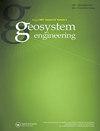Assessing the Lithium Potential of the Paleoproterozoic Rocks of the West African Craton; the Case so Far
IF 1.1
Q3 GEOSCIENCES, MULTIDISCIPLINARY
引用次数: 0
Abstract
ABSTRACT This review presents a preliminary account of the Lithium exploration sector in the Paleoproterozoic rocks of West Africa, a relatively new field of research, and assesses its future prospects in light of the green transition-driven demand for the metal. The deposits in Ghana, Mali, Burkina Faso, Côte d’Ivoire, Senegal, and Niger form the basis of this study. The WAC predominantly possesses LCT pegmatites while a few with hybrid LCT + NYF characteristics have been reported, such as the Mangodara pegmatite district in southeastern Burkina Faso. The terrane’sanalysed pegmatite deposits contain 1.11–2.0% Li2O. The pegmatites may form as a swarm of dykes in peraluminous granites of varied composition formed from Eburnean continent – continent collision. They typically contain spodumene, quartz, feldspar, muscovite, lepidolite, beryl, tourmaline, and fluorite. Spodumene is the most prevalent lithium-bearing mineral in the deposits, with the occurence of rare secondary lepidolite and zinnwaldite. Dyke thickness, ranging from 10 to 80 metres, may affect the pegmatites’ lithium-bearing potential. Hydrothermal alteration albitizes and greisenizes pegmatitic structures. Despite the pegmatites’ varied genetic features, the Goulamina and Issia deposits in La Cote d’Ivoire have an inferred genetic link with their host granites. The WAC’s Paleoproterozoic lithium-bearing pegmatites share certain traits that make them easier to extract. Lithium exploration in West Africa depends on geological investigations, technological improvements, investor funding, and environmental concerns.西非克拉通古元古代岩石锂电位评价到目前为止的情况
本文章由计算机程序翻译,如有差异,请以英文原文为准。
求助全文
约1分钟内获得全文
求助全文

 求助内容:
求助内容: 应助结果提醒方式:
应助结果提醒方式:


